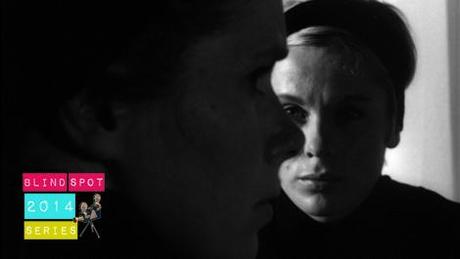
As you may know, I wasn’t a fan of Ingmar Bergman’s Wild Strawberries (1957), which is my first Blind Spot this year. Persona (1966), however, is possibly the blackest and beautiful drama I’ve ever watched, in the most excellent way.
Black and white photography fascinates me. It shows how in limited colors or in monochrome world, things can be beautiful and classy at the same time. It also looked timeless. Some great classic movies have beautiful actors and possibly the most expensive set at the time, but nothing really compliments black and white as in Persona. Not much movies have used the essence of black and white as perfect as this movie.
It is about a nurse, Alma (Bibi Andersson) assigned to take care of a well-known actress, Elisabet Vogler (Liv Ullmann), who is analyzed to be healthy mind and body, but unwilling to speak. When the head of the nurse suggests that Elisabet stayed in her place near the beach, Alma becomes close to her and thinks of her as her best friend. Alma opened up to her, since she find Elisabet a great listener. She tells her about her relationship, her abortion and her deepest secrets. But then Alma discovers that the actress isn’t listening, but studying her, which makes her feel used. As Alma loathe Elisabet, she slowly understand why the woman is in silence and how maybe both of them aren’t that different.

I have never seen anything like Persona, and it might be the first ‘horror’ movie that I find as a breakthrough, so modern in its time and even now. Many movies now trapped with labels, but it doesn’t. It doesn’t afraid to be anything than its own. The essence is a mix between the fascinating black and white photography (the overlap faces and the contrasts colors and angles), and the ‘bubble’ of the two woman in it. The ‘bubble’ is Alma and Elisabet’s world, they are so connected they are like sisters (and at some point, like lovers). Though Alma talks a lot and Elisabet is the opposite, at some point they feel like reading each other’s mind and loathe each other like they have been in relationship for years. Amazingly, their dark worlds also connected and it’s the horror that haunts woman. (Spoilers ahead)
The subject, what Elisabet is keeping from everybody, seem to be what many modern woman facing today. After having a career of their own and loving their independence, a role of a mother can be strange and exhausting. Some women embrace the responsibility, some women like Elisabet refused to be it. It is a horrible respond for society one can’t voice out loud because it will taint their image. I think, however, Elisabet have been faking too much to unravel her true colors. But in many ways, escaping her role as mother with silence is pretty harsh and selfish. The horror of it was it came from an actress with an innocent face.
Instead of making the movie as a drama, Bergman focuses on the horror and the darkness of the mind. It doesn’t exaggerate and doesn’t visualize crazy imagination, but it does visualize the dryness and gloomy state of mind. And excellently, the two different characters emerged and actually have the same life choices. What made it even greater, was the cold ending without no branch to a new possible story. It feels like a door creaking and shutting carefully.
It’s a masterpiece that I won’t forget, both visually and story. I don’t know the connection between the horror clips in the opening, and I probably won’t understand. But after watching the rest, I don’t care that they don’t match the story. I was drawn to Alma and Elisabet with their shadowy stories, their beautiful faces and stranded souls. Just maybe, this movie is the beginning of the rest of Bergman movies that I will love.
Final Score :

